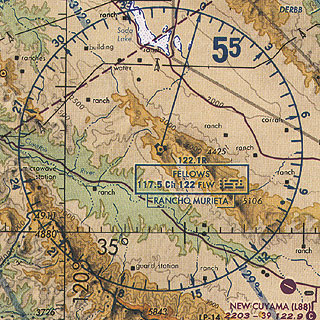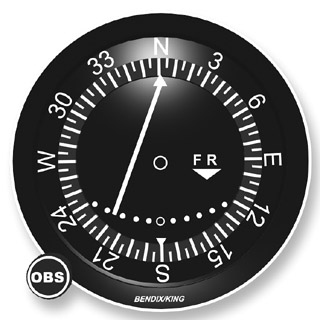Excerpted from Cleared for Takeoff, copyright 1998, King Schools, Inc.
The figure below shows you a VORTAC, and the communications box associated with it. We'll try to decipher what all this stuff means.

First, the station symbol comes equipped with those tick marks, so you know right away that this is really a VORTAC. The communications box tells you that its name is Fellows, and in order to receive the station, you need to dial frequency 117.5 into your navigation receiver.
|
Related Links
|
||||||||||||||
It also tells you that FLW is the three-letter identifier for this station, so, if you've entered FLW in your flight plan, everyone would know that you're flying to the Fellows VORTAC because there is no other FLW in the country.
Dit–Dah, Dah–Dit
Now, here's something that will be truly helpful to you: If you tune 117.5 into your nav radio, turn up the volume and listen; you'll hear the Morse code for that 3-letter identifier. If, like most of us, you can't interpret Morse code without your decoder ring, the FAA has taken pity on you.
So, when you start hearing that dit-dit-dah-dit, all you need do is listen, follow along, and then compare the dots and dashes you hear with the dots and dashes for the VOR identifier in the frequency box (..- . .-.. .- -).
So, for Fellows, you'd listen for "dit-dit-dah-dit...dit-dah-dit-dit...dit-dah-dah." Compare that with what you see on the chart and you'll know that you're tuned into FLW and not some other VOR.
Is the Right VOR Tuned, and Can You Count on It?
A Morse code identifier and, occasionally, a voice ID, are transmitted from each VOR. And although it may not seem necessary to identify VORs in this age of digital tuning, listening to the identifier is still the only way to verify that the VOR is in service and reliable—and that you've not made an error dialing in the digits.
If the identifier is not being transmitted, the VOR signal should not be considered reliable. When maintenance crews work on a VOR—perhaps to realign the signal—they remove the ident code, but often leave the VOR navigation signal on the air. So always identify the VOR first.
Who's That You're Talkin' to?
If you look beneath the Fellows VORTAC communications box, you'll see that Rancho Murieta is the controlling flight service station. That's who you'd talk to, if you needed to talk to the Flight Service Station (or FSS) through this facility.
Note the 122.1R on top of the box. The "R" means that the FSS can only listen to you (receive); it can't transmit on that frequency.
So, if you set 122.1 in your comm radio, they can hear you, but you can't hear them on your comm radio. They can, however, transmit over the VOR frequency, so you'd be able listen to them on your nav receiver. So, at FLW, you'd call Rancho Murieta FSS on 122.1, and listen to them on 117.5.
If there were other frequencies listed above the box without the "R," then you could talk and listen on those frequencies on your comm radio.
How Does VOR Work?
VORs work on the principle of the phase difference in two radio signals.
"Phase Difference?" you say. "Is this going to be some dreary electronics discussion like the ones we used to have in high school physics class that always put me in detention hall because I'd fall asleep?" No. It will not.
You can get your mind around this concept by thinking of a tower with two lights on it. One light rotates at a constant rate around the tower but has a very narrow beam so that it can only be seen by the viewer just as the beam passes the viewer's position. The other light flashes—and can be seen in all directions (an omnidirectional light)—only when the rotating light exactly passes magnetic north.
If you know how fast the rotating light is moving, it's a simple matter to start a timer when the omnidirectional light flashes, just as the rotating light passes north, and then note the time when you see the rotating beam aim at your position. Then, with just a little math you'll know your bearing from the station.
That's how a VOR works. A rotating directional signal is broadcast from the VOR, while a second (omnidirectional) signal is broadcast only when the rotating signal passes north. The VOR receiver in your aircraft measures the time—or phase—difference in these two signals and comes up with the bearing—or radial—from the station.
Old but Reliable
In spite of the age and limitations of the system, all of the airways in the United States, and most of the world, have been built on the radials of VORs. The highways in the sky charted from VOR to VOR have been the backbone of air navigation for decades.
And now that you know all about VOR stations, you'll know how to identify them and when they are reliable to use for that long cross-country trip of yours. Plus...you'll have added another round of ammunition to your arsenal of amazing aviation acronyms!
So, now you can recognize a VOR when you see one on a chart. And you know where to find all the information you'll need to use a VOR for navigation. So let's look inside your airplane and see where the VOR lives in the cockpit.
The VOR Indicator
Besides the nav receiver—where you set the frequency and volume—you need a way to visualize those VOR radials. And they've given you a pretty ingenious system to pick the radial you're interested in and then show you where you are in relation to it. Amazingly, it's all in one package that's referred to, cleverly enough, as the VOR indicator.
Notice that the VOR indicator has a rotating compass card, giving it a look similar to the heading indicator. And just like the heading indicator, there's a knob at the lower left which turns the card.

Omni Bearing Selector
The difference is that this knob on the VOR indicator is labeled "OBS", which stands for "Omni Bearing Selector." On this instrument, the card only moves when you move it. So, you turn the OBS knob to select a VOR radial, or course, which you read at the top of the arrow. You have 360 possible choices.
Course Deviation Indicator
Consider the vertical needle in the center of the indicator. It's hinged at the top and swings left or right. It's called the "Course Deviation Indicator" or "CDI," but commonly referred to as the "needle."
Think of the needle as an imaginary centerline on a highway. If you're on the right side of the highway, the centerline—or your needle—is to the left. If you move toward the left, then, as you approach the center of the highway, the needle moves toward the center of the instrument.
But if you continued left, past the center, the needle would move past center, toward the right side. In flight, you navigate a radial, or course, by keeping the needle in the center, and if it moves to one side, you move toward it. Remember: Fly toward the needle.
How Wide is the Road?
So how wide is the aerial highway? From a centered needle to a full needle deflection measures 10 degrees, so if the needle is on the outermost dot, you are 10 degrees off your selected course.
As you can see from the figure above, the face of a VOR indicator has equally spaced dots so you can tell how far you are off course. If your CDI has 5 dots on either side of center, like this one, then each dot your needle deflects is equal to 2 degrees. You can actually count how many degrees off you are, up to a maximum of 10 degrees.
If the needle is pegged against the side of the instrument, you don't really know how far off course you are, just that it must be more than 10 degrees.
Since the CDI shows your angle off course, not your distance, your actual distance off course will vary with how far you are from the station. For instance, if you're 60 miles from the station, a 1 degree needle deflection means you are 1 mile off course. But if you're only 15 miles from the station, that same 1degree of needle deflection tells you that you're only 1/4 mile off course. This explains why the needle moves so dramatically when you get close to the VOR station.
To/From Indicator
Also in the center portion of the indicator, there's a window that reads TO on a white background with a small triangle pointing up, or FR for "from" with a triangle pointing down ... or it could be filled with a red and white crosshatched symbol, called the Nav Flag or the Off Flag. Some To/From indicators may just only be up and down triangles. (The up arrow is TO.)
The To/From indicator tells you whether the course you have selected on the OBS is a radial from the station, or a course to the station. It does not tell you whether your current heading will take you to or from the station.
When your Off Flag shows in the window, it tells you that you have an unreliable signal and you shouldn't use that station for navigation. However, the Off Flag may also appear, momentarily, as the To/From indicator changes from one to the other when you fly over or past the station.